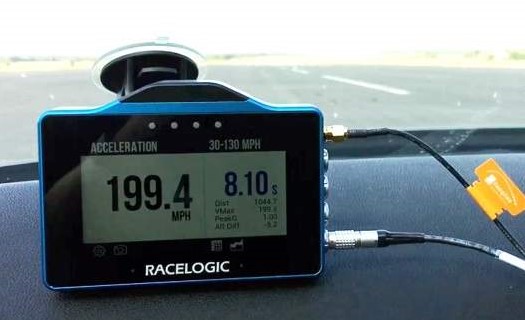VBOX Touch Accel/Decel Test Aborted
- Last updated
-
-
Save as PDF
-
You can perform Accel and Decel performance tests with VBOX Touch. If you are doing a test and the run gets aborted before the end conditions are met, the most likely cause is that a drop in satellites has invalidated that run.
VBOX Touch will only present accurate results rather than attempting to predict data, so if VBOX Touch cannot detect a satellite signal during a test run, that run will get aborted to provide correct data only. The data recorded before the run was aborted will still get saved to the SD card for post-analysis.
It is crucial that you make sure that your VBOX Touch has the optimum conditions for recording data. Please follow the guidance below to avoid it aborting performance tests in the future.
Using Internal Antenna
VBOX Touch has an internal patch antenna. This means that in most circumstances where the unit has a clear view of the sky, you do not need an additional antenna. However, satellite signals can be influenced by various factors.
Mounting Location
You should make sure to mount the unit on the windscreen, in a suitable location and adjust as necessary. You need to minimise potential interference from features such as roof bars and windscreen wipers as much as possible.

Athermic Windscreens
Some modern cars are fitted with a special windscreen that cuts down the amount of UV (Ultra Violet) rays transferred through it, which helps reduce glare. These windscreens are called athermic or UV Coated. This type of windscreen will also dampen or reduce GPS signals coming through it. This means that if you have an athermic windscreen, you will not receive the same signal quality as you would if your VBOX Touch was outside of the car.
If you do not know if your windscreen is athermic, the manufacturer of your vehicle or the primary authorised dealer may be able to tell you. If you cannot receive a firm yes or no, you can test it by powering up your VBOX Touch and holding it outside of the vehicle. Wait until it acquires a satellite lock. Use the Diagnostic Settings screen to see how many satellites it can detect. Note the information down and move the unit inside the car. If the GNSS signal immediately drops by 2-4 satellites, it is likely that you have an athermic windscreen.
Using External Antenna (RLACS262)
If you are using an external antenna (RLACS262) and the unit is having trouble acquiring a satellite lock, follow the checklist below to test the typical solutions.
Common problems with GNSS antennas are due to damage to the cable or the connector. You must place the cable in a position that avoids tight angles from being inflicted on the cable and damaging the thin core.
- Make sure that the antenna is placed in a position where it has an unobstructed view of the sky (see GNSS Antenna Placement below).
- Check the antenna connection with VBOX Touch. Even small amounts of dirt in the socket can cause a significant reduction in signal strength. Also, check for damage to the cable at the plug and along its entire length.
- If you have one available, try another known working antenna, to confirm the functionality of the antenna.
- Perform a GPS Coldstart and then leave the unit powered up in an open static position for at least 15 minutes.
GNSS Antenna Placement
![]()
To achieve optimum GNSS signal reception, you need to make sure that the antenna is fitted to the highest point on the vehicle and away from any obstructions that may block satellite reception. The GNSS antenna works best with a metal ground plane underneath. If you don't have a metal roof, a piece of silver foil, or a metal plate beneath the antenna can improve reception significantly.
Click here for more information on antenna placement.

